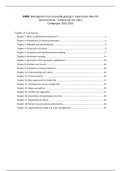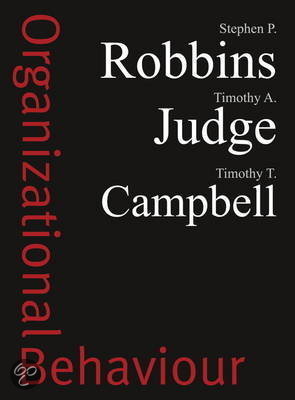1JK00: Management van menselijk gedrag in organisaties (Non IE)
Samenvatting – Lindsey van der Aalst
Collegejaar 2015-2016
Table of Contents
Chapter 1: What is organizational behaviour? ................................................................................... 2
Chapter 2: Foundations of individual behaviour ................................................................................ 4
Chapter 3: Attitudes and job satisfaction ........................................................................................... 6
Chapter 4: Personality and values ...................................................................................................... 8
Chapter 5: Perception and individual decision making .................................................................... 11
Chapter 6: Motivation concepts ....................................................................................................... 14
Chapter 7: Motivation: from concepts to applications ..................................................................... 19
Chapter 8: Emotions and moods ...................................................................................................... 21
Chapter 9: Foundations of group behaviour..................................................................................... 23
Chapter 10: Understanding work teams ........................................................................................... 26
Chapter 11: Communication ............................................................................................................. 28
Chapter 12: Basic approaches to leadership .................................................................................... 31
Chapter 13: Contemporary issues in leadership ............................................................................... 33
Chapter 14: Power and politics ......................................................................................................... 36
Chapter 15: Conflict and negotiation................................................................................................ 37
Chapter 16: Foundations of organization structure ......................................................................... 39
Chapter 17: Organizational culture................................................................................................... 42
Chapter 18: Human resource policies and practices ........................................................................ 44
Chapter 19: Organizational change and stress management ........................................................... 45
,Chapter 1: What is organizational behaviour?
Managers: individuals who achieve goals through other people. (are also called administrators,
especially in not-for-profit organizations).
Organization: a consciously coordinated social unit, composed of two or more people that functions
on a relatively continuous basis to achieve a common goal or set of goals. (e.g. manufacturing firms,
police departments, churches).
Management functions:
At first there were five management functions: planning, organizing, commanding, coordinating and
controlling, but now we have condensed these to four:
1. Planning: includes defining goals, establishing strategy, and developing plans to coordinate
activities. This function increases the most as managers move from lower-level to mid-level
management.
2. Organizing: determining what tasks are to be done, who is to do them, how the tasks are to
be grouped, who reports to whom and where decisions are to be made.
3. Leading: includes motivating employees, directing others, selecting the most effective
communication channels and resolving conflicts.
4. Controlling: monitoring activities to ensure that they are being accomplished as planned and
correcting any significant deviations.
Mintzberg’s managerial roles (10 types of behaviours per manager):
Interpersonal
Figurehead: required to perform a number of routine duties of a legal or social nature. E.g. handing
out degrees.
Leader: responsible for the motivation and direction of employees. E.g. hiring.
Liaison: maintains a network of outside contacts who provide favours and information.
Informational
Monitor: receives a wide variety of info; serves as nerve centre of internal and external info of the
organization.
Disseminator: transmits info received from outsiders or from other employees to members of the
organization.
Spokesperson: transmits info to outsiders on organization’s plans, policies, actions and results;
serves as expert on organization’s industry.
Decisional
Entrepreneur: searches organization and its environment for opportunities and initiates projects to
bring about change.
Disturbance handler: responsible for corrective action when organization faces important,
unexpected disturbances.
Resource allocator: makes or approves significant organizational decisions.
Negotiator: responsible for representing the organization at major negotiations. Discuss issues and
bargain with other units to gain advantages for their own unit.
Three essential management skills:
1. Technical: the ability to apply specialized knowledge or expertise.
2. Human: the ability to work with, understand and motivate other people, both individually
and in groups.
3. Conceptual: the mental ability to analyse and diagnose complex situations.
Managerial activities:
1. Traditional management. Decision making, planning and controlling.
, 2. Communication. Exchanging routine info and processing paperwork.
3. Human resource management. Motivating, disciplining, managing conflict, staffing and
training.
4. Networking: socializing, politicking and interacting with outsiders.’
Connection between networking and successful managers (speed of promotion) and connection
between communication and effective managers (quantity and quality of their performance and the
satisfaction and commitment of their employees).
Organizational behaviour (OB): a field of study that investigates the impact that individuals, groups
and structure have on behaviour within organizations, for the purpose of applying such knowledge
toward improving an organization’s effectiveness.
Systematic study: looking at relationships, attempting to attribute causes and effects and drawing
conclusions based on scientific evidence.
Evidence-based management (EBM): basing managerial decisions on the best available scientific
evidence.
Intuition: a gut feeling not necessarily supported by research.
OB is based on the disciplines:
-psychology: the science that seeks to measure, explain and sometimes change the behaviour of
humans and other animals.
-social psychology: an area of psychology that blends concepts from psychology and sociology and
that focuses on the influence of people on one another.
-sociology: the study of people in relation to their social environment or culture.
-anthropology: the study of societies to learn about human beings and their activities.
While psychology focuses on the individual, sociology studies people in relation to their social
environment or culture.
Contingency variables: situational factors: variables that moderate the relationship between two or
more other variables.
Workforce diversity: the concept that organizations are becoming more heterogeneous in terms of
gender, age, race, ethnicity, sexual orientations and inclusion of other diverse groups.
Globalization focuses on differences between people from different countries, workforce diversity
addresses differences among people within given countries.
Almost every industry suffers from excess supply. E.g. Automobile factories can build more cars than
consumers can afford.
Leads to increased competition.
Positive organizational scholarship: an area of OB research that concerns how organizations
develop human strength, foster vitality and resilience, and unlock potential. Also called: positive OB.
Too much research about what’s wrong with organizations, so this area investigates what’s good
with organizations.
There are three levels of analysis in OB: individual level – group level – organization systems level.
Each level is constructed on the previous level.
, Dependent variable: a response that is affected by an independent variable.
Primary dependent variables in OB:
- productivity: performance measure that includes effectiveness and efficiency.
Effectiveness: achievement of goals.
Efficiency: the ratio of effective output to the input required to achieve it.
A hospital is effective when it meets the needs of its clients and it is efficient when it can do so at
low cost.
- Absenteeism: the failure to report to work.
- Turnover: voluntary and involuntary permanent withdrawal from an organization.
- Deviant workplace behaviour: voluntary behaviour that violates significant organizational
norms and, in so doing, threatens the well-being of the organization or its members. Also
called antisocial behaviour or workplace incivility. E.g. playing loud music, theft.
- Organizational citizenship behaviour (OCB): discretionary behaviour that is not part of an
employee’s formal job requirements, but that nevertheless promotes the effective
functioning of the organization. E.g. helping others on their team, avoiding conflicts,
volunteering for extra work.
- Job satisfaction: positive feeling about one’s job resulting from an evaluation of its
characteristics. Represents an attitude rather than a behaviour.
Independent variable: presumed cause of some change in a dependent variable.
- Individual-level variables. Biographical characteristics (age, gender etc.), ability, values,
attitudes, personality, emotions. Perception, individual decision making, learning,
motivation.
- Group-level variables.
- Organization system-level variables. The design of the formal organization, the
organization’s internal culture, the organization’s human resource policies and practices
(e.g. training).
Chapter 2: Foundations of individual behaviour
Ability: an individual’s capacity to perform the various tasks in a job.
Intellectual abilities: the capacity to do mental activities: thinking, reasoning, problem solving.
Dimensions of intellectual ability:
1. Number aptitude
2. Verbal comprehension
3. Perceptual speed
4. Inductive reasoning
5. Deductive reasoning
6. Spatial visualization
7. Memory
General mental ability (GMA): overall factor of intelligence, as suggested by the positive
correlations among specific intellectual ability dimensions.
Physical abilities: capacity to do tasks that demand stamina, dexterity, strength, and similar
characteristics.
Biographical characteristics: personal characteristics – such as age, gender, race, and length of
tenure (work experience) – that are objective and easily obtained from personnel records.






